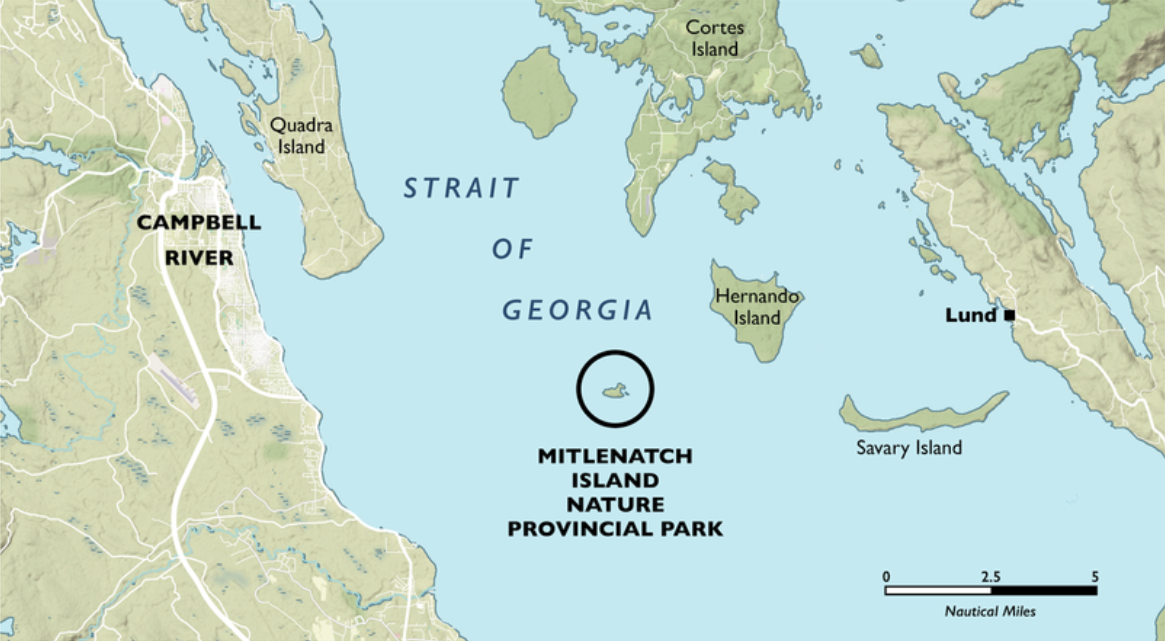We’ve been fortunate to visit Mitlenatch Island more than once. It’s home to the largest seabird colony in the Strait of Georgia, with glaucous-winged gulls, pelagic cormorants and pigeon guillemots being the most abundant birds.
Mitlenatch Island Nature Provincial Park is a great stop on the way to Desolation Sound, Cortes and the rest of the Discovery Islands. The 35.5-hectare island lies just south of Cortes and became a provincial nature park in 1961. Because the Vancouver Island mountains to the island’s west catch the moisture from Pacific Ocean clouds, Mitlenatch is dry, with a semi-desert climate. Even a species of cactus grows here.
In the past, Coast Salish people fished and gathered eggs and camas here. I’d wondered if the island’s name is German, but it’s an English adaptation of a Sliammon (Tla’amin Nation) term meaning “calm waters all around.” The island once belonged to the Cortes-based Manson family, who raised cattle and sheep here. Family members lived on the island during the summer to discourage “mutton pickers.”
My husband, David, and I had spent a windy night in Sturt Bay on Texada, then sailed further north toward Mitlenatch. For years we’d planned to visit this bird sanctuary and park, but this time everything—especially the weather—was propitious. There’s a shallow anchorage in Camp Bay on the island’s east side, but as Beyond the Stars’ draft is 6.5 feet and the winds were light southerly, we opted to anchor at the northwest side. To get there, we ran along Mitlenatch’s west side, where low-lying rocks provide a tanning salon for seals. Above them, sheer, black, volcanic basalt cliffs decorated with long streaks of white guano offer a roost for pelagic cormorants who build their nests and raise their young in cracks and tiny caves.
Pigeon guillemots flashed their red legs and white-tipped black wings. They lay their eggs in rocky cavities near water, but will often nest in any available hollow, including caves and the abandoned burrows of other seabirds. We spotted a group of oystercatchers pecking away at edible bits in the rocky shallows (despite their name, oystercatchers do not eat oysters, a pity, as Mitlenatch has extensive oyster beds, although visitors need to be aware that shellfish collection is not permitted here). And above these colonies, flocks of glaucous-winged gulls live by the thousands and together provide a veritable concert—some would say, cacophony—of gull sounds.
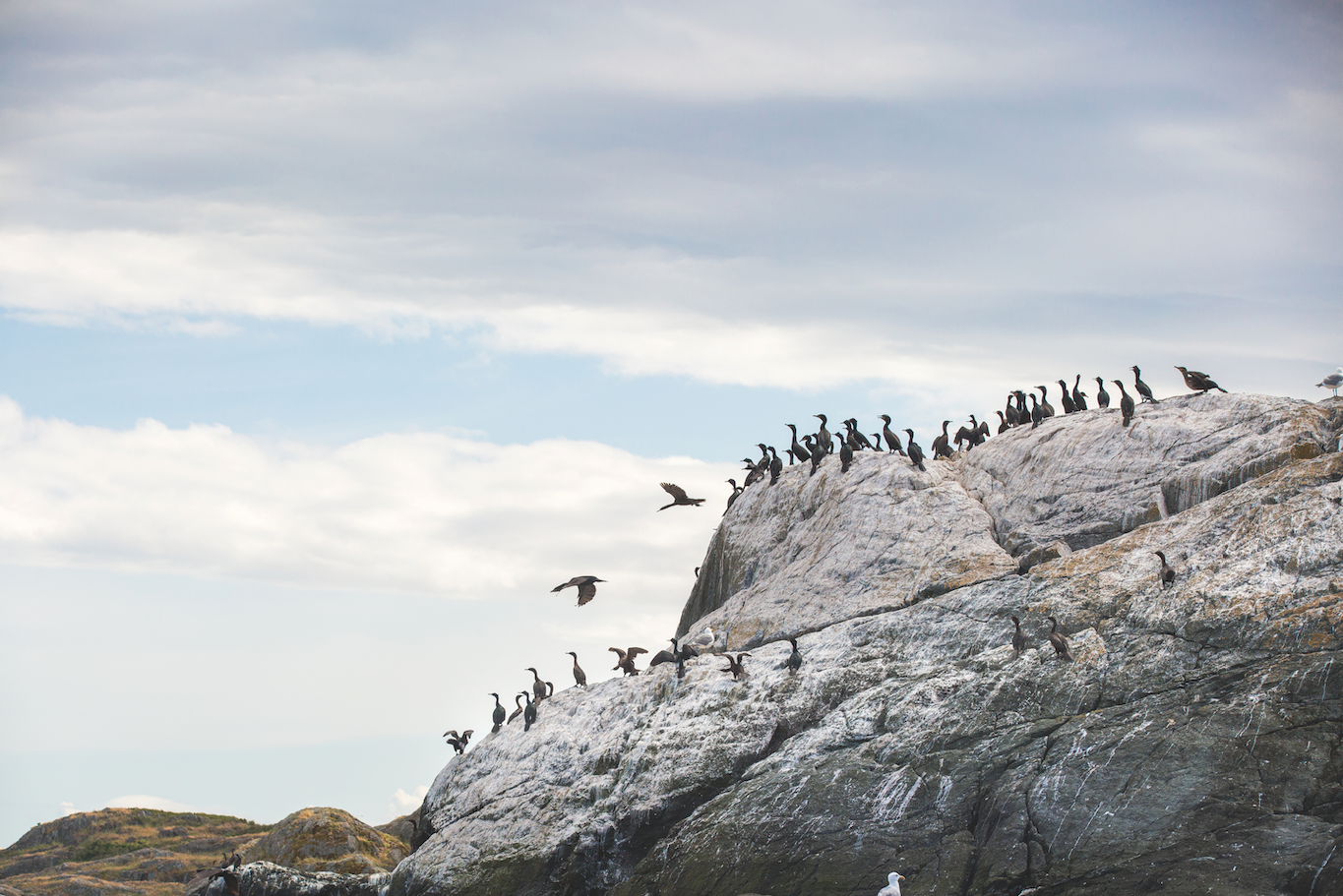
Our first visit to Mitlenatch took place in early June. At that time, the more than 3,000 gulls that live and breed among the barren rocks, were brooding and guarding the eggs they’d laid in their individual nests. When seen from the air it’s obvious that glaciers abraded the basaltic rocks grinding deep crevasses—all in the southeasterly direction. The crevasses, clefts and cracks with their bits of grasses, create a wonderful habitat for gull nests. These birds begin claiming their individual breeding territory in April and defend their nesting area vigorously. Toward the end of May, eggs occupy the nests with hatchlings appearing toward the last part of June. Child rearing takes until early August.
We’d anchored off Northwest Bay and rowed our dinghy ashore landing on a beach of rounded granite globes, some resembling speckled eggs themselves. A long file of gulls occupied the intertidal zone and seemed indifferent to our presence. When I looked up, I noted seven eagles floating high up on the thermals.
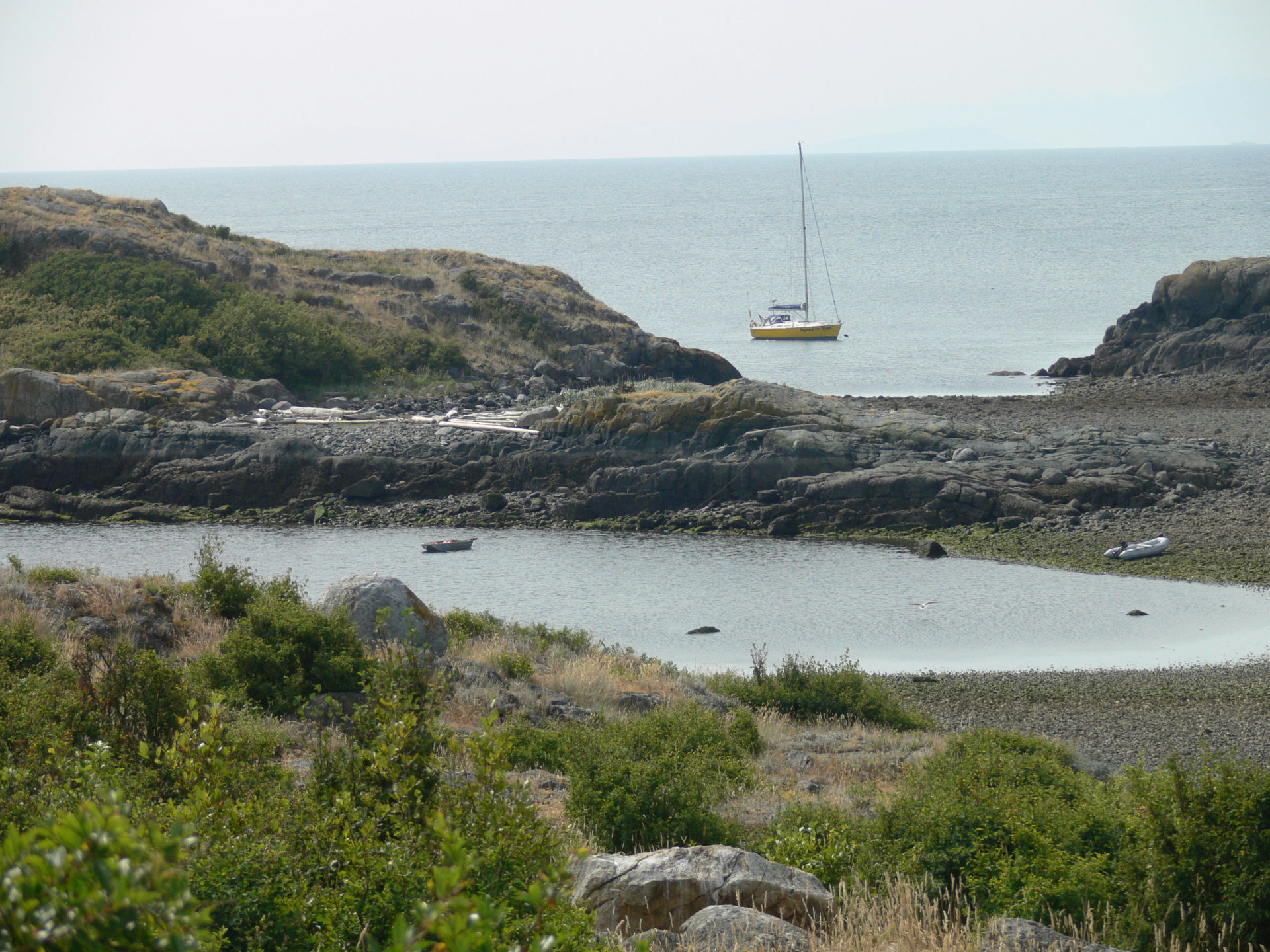
The sanctuary allows visitors in the central section of the island, while the cliffs are off limits. Paths are cut into the grasses, shrubs and other foliage. To enter the path, we clambered over some massive driftwood tree trunks. Although the sun was hot, a light breeze kept us comfortable; a few insects buzzed around us. Tiger lilies, wild onion, buttercups, white fawn lilies, beach peas, wild roses, blooming salal and tall grasses full of seed surrounded us. The paths had been cleared recently as fresh cut-marks on ferns and branches were evident. David had walked ahead of me and I veered off toward some low trees. A dark shadow sat motionless on one of the branches.
As I closed in on the tree, the bird—an immature, brown eagle—swept away. I could hear the swoosh of its wings. But it didn’t fly up. It swooped low over the brooding gulls who rose in great numbers. Rarely have I heard such strident caterwauling. The king of the birds paid no attention to the screams. It landed, snatched an egg or two and was off again instantly. Nature, red in tooth and claw.
As I followed the path down to Mitlenatch’s east side, I heard David calling. “Come and meet the caretakers,” he said. “They’re Dutch” (being Dutch myself, it sometimes seems my compatriots are everywhere). Shortly thereafter, I met Jaap (Jake is his English name) and Ady DenDekker, who for the seventh time, were spending a week volunteering in the park. Their home for this venture was a small hut with two tiny rooms. The island’s ample driftwood had provided the hut’s construction materiel. A lean-to was equipped with a two-burner Coleman stove; a propane fridge kept a few foodstuffs fresh. A crude rocking chair made of driftwood sat in the small courtyard. Lacking electricity, the pair used candles and a battery-operated radio to provide light and entertainment. Water is stored in squat plastic bottles.
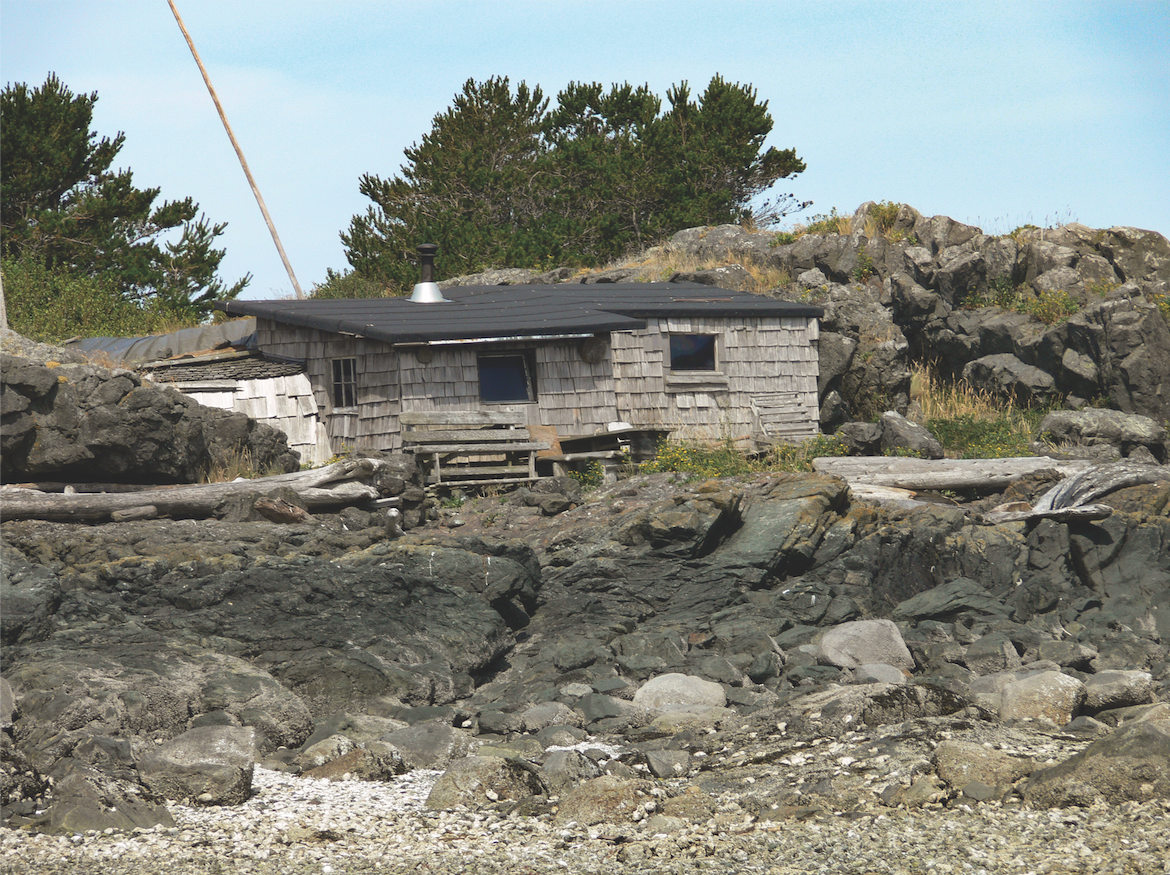
Inside the hut, two wooden platforms serve as beds, but Ady had opted to bring a small tent, which can be tightly zippered. “I don’t sleep in there,” she said to me in Dutch. “There are so many mice and I hate it when they walk across my body at night.” She pointed toward the sleeping bag-covered wooden bench. “Jaap doesn’t mind the critters so he sleeps over there.”
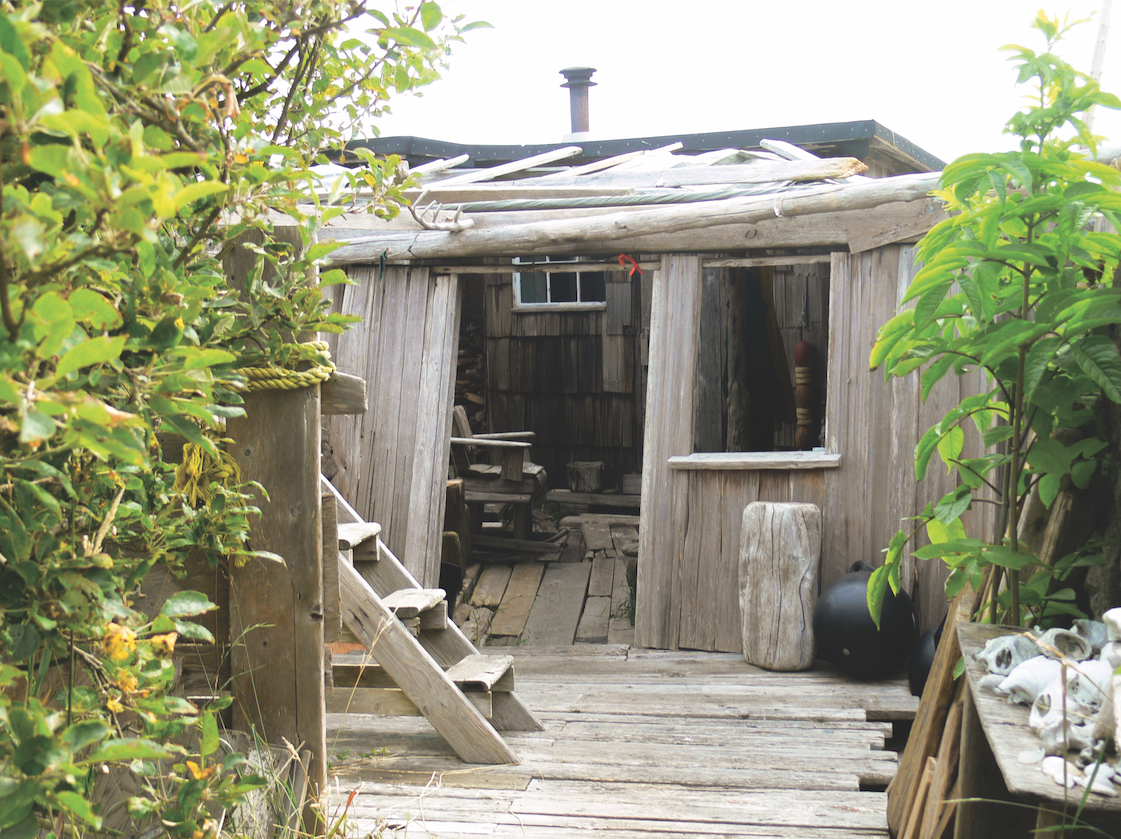
The DenDekkers and the other volunteers who perform park duties clear the trails, ensure no dogs come ashore (they’d wreak havoc on the nesting birds), and provide information on the avians and other animals that live on this island. Another island resident, the garter snake, has evolved into a much larger size than those in more southern locations—some reaching two metres. The snake, with its white and gold markings is not poisonous to humans, and likely keeps the mice population down.
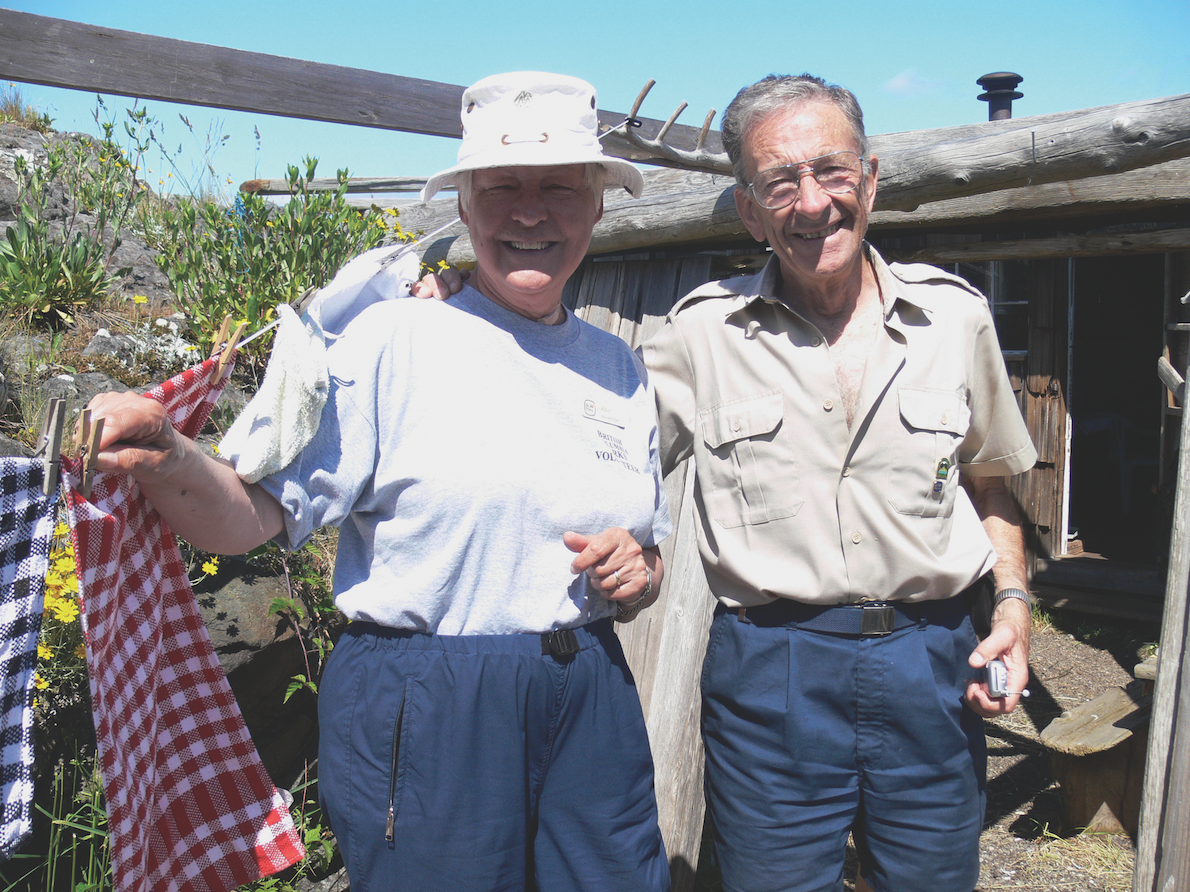
The volunteers are part of the Mitlenatch Island Stewardship Team (MIST), a non-profit group that organizes the volunteer wardens who live on the island for a week at a time. Their job, according to the website, is “to protect the nesting birds, contribute to scientific monitoring programs and ensure visitors don’t encroach on protected areas and damage the ecosystem while they’re here.” The wardens also contribute to eight scientific monitoring programs that include bird counts; beached bird surveys on the causes and rates of seabird mortality; when the 25 island species of plants bloom; intertidal communities’ surveys; mapping of eelgrass beds; sightings of cetaceans and turtles and removal of invasive species.
The DenDekkers pointed us toward the gull blind, a rough wooden structure on the east hill, where, if you’re seated or standing quietly, you can watch the gulls as they perform their family duties. Signs explain gull behaviour such as choking, salt secretion, begging and various calls.
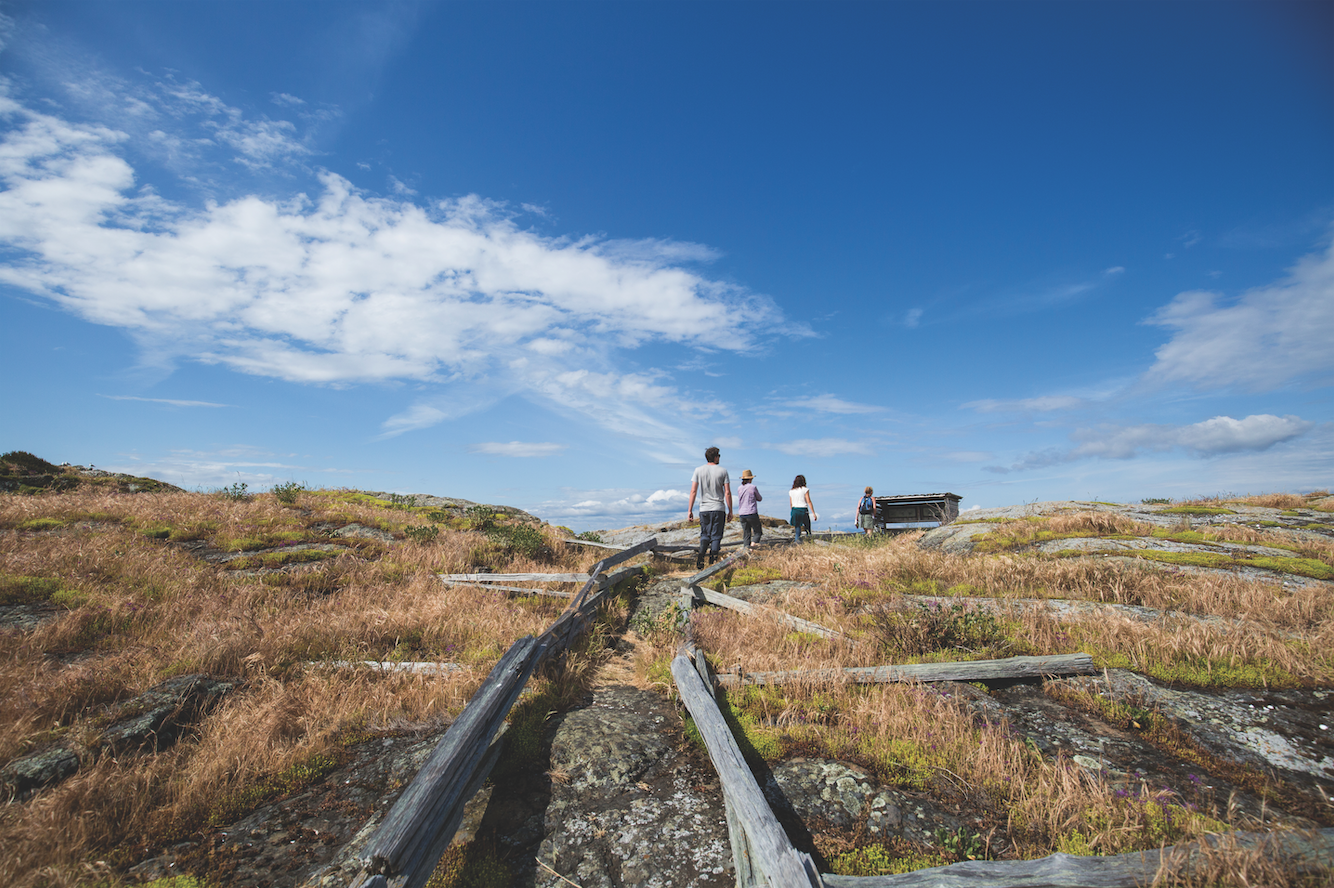
We hiked up to the gull blind, which allowed us to spy the gulls otherwise hidden from view. While we were there, no eagles pounced on them.
I’ve always been fascinated by the many cries gulls are able to make. Sometimes, usually at daybreak, they cluck softly, happy to be alive. They’ll screech to ward off a territorial invader. Their scream is of a higher pitch when there’s food to be had and soon their gull cousins, hearing the call, wing in to capture their share of the booty. If a predator is around—eagles are certainly enemies—they’ll send out a three-alarm shriek, raising the threat level to red, “a terrorist is on its way.”
Our second Mitlenatch visit was a couple of years later in July. A month makes a big difference in the gulls’ lifecycle. Again, from the blind, we could see the eggs had hatched and brownish fluff balls meandered in the hollows, anxiously watched over by their parents. The eagles were as avid as ever and had merely switched targets. On our way from the beach, we’d heard the same screams, the same caterwauling from the gulls. Every 20 minutes or so, the scene would repeat. Swoop, screech, rising birds, relative quiet. Being located behind the cliffs, we couldn’t tell how successful the eagles were in capturing a chick, but it certainly wasn’t for want of trying.
We’d spent the previous night there on Beyond the Stars, anchoring south of the island, with winds varying from 16 to 22 knots from the northeast. Although we were somewhat protected by the island’s cliffs, our exposure was still extensive. Would it be safe? We set anchor watches for 02:00 and 05:00 to make sure we weren’t dragging, but the Delta anchor was securely buried, the boat swung in its arc, the snubber stretched in the wind. In between anchor alarms, we slept like babies in a gently rocking cradle.
The next morning, the tide falling, we were again treated to the numerous birds. Oystercatchers chirped their distinctive song, pigeon guillemots dove incessantly, cormorants hung out on their guano-covered cliffs. We dinghied into the small baylet on the east side of the island. On the way, a huge family of harbour seals were once again sunning themselves, their Dalmatian spots providing excellent camouflage against the blackish rocks. Although a bit nervous about our presence, they posed for my camera, nose in the air. Sea lions also roost on Mitlenatch, but we were too late in the season to spot them.
Camp Bay’s long, long tidal beach was cloaked in layers of oysters who’ve been reproducing here for decades without interference. Some of them were larger than my hand and, covered in barnacles, they were strong enough to resist our weight as we crunched across them. It was tempting to collect a quick bucket for dinner, but we abided by Mitlenatch’s rules of leaving everything as we found it.
In July, Mitlenatch’s vegetation is thick and lush. Amazingly, in the wild, those weeds that multiply so fast in our monoculture lawns—dandelions, buttercups—keep a modest profile. We could see that the week’s volunteer wardens, who again occupied the weathered, silvery shack at the head of the baylet, were camping there, but we never laid eyes on them as we traipsed along the sunlit, narrow paths. These had been recently cut to improve access.
Other than the unseen wardens, we were all alone on the island. It was a glorious day and although we were strolling on paths, the island was very natural. Wild roses bloomed. Bees buzzed. It was one of these experiences that evoke your wonder, that makes you happy to be alive and count yourself lucky for the chance to experience it.
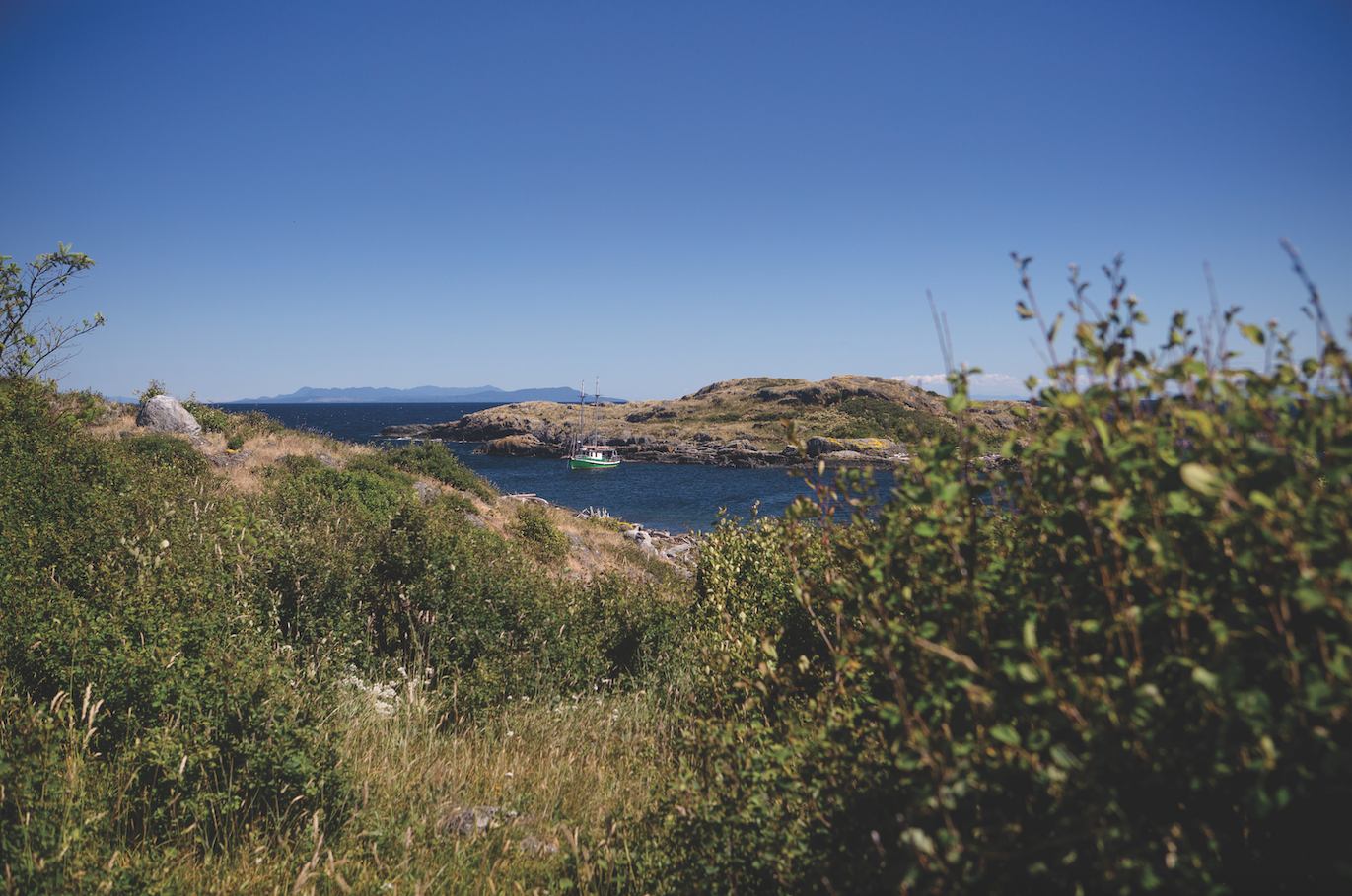
Mitlenatch Island Rules
- Accessibility to the island is only by boat. Land only at the beaches at Camp Bay on the south, or at Northwest Bay on the north.
- Visitors must stay on paths. Much of the island is restricted.
- No camping is permitted.
- The MIST volunteer cabin is used by volunteers only and is not open to the public.
- Pets of any kind are not permitted.
- Smoking and campfires are strictly forbidden.
- When approaching the observation blind keep your party together and move slowly.
- Don’t remove anything from the park including flowers, bones, feathers, shells, stones, shellfish.
- Nesting cormorants are best viewed quietly and at least 50 metres from a slow-moving boat.
- Do not feed any animals—human food can harm wild animals; they can quickly become habituated and aggressive.
- The park has two pit toilets, located near the host cabin on Camp Bay.
When You Go
Location: 49.950747, 125.004125
Charts: 3513, 3538
Nearest Provisions: Campbell River, Lund, Cortes Island
For further information:
mitlenatch.ca/mitlenatch-island
env.gov.bc.ca/bcparks/explore/parkpgs/mitlenatch_is
